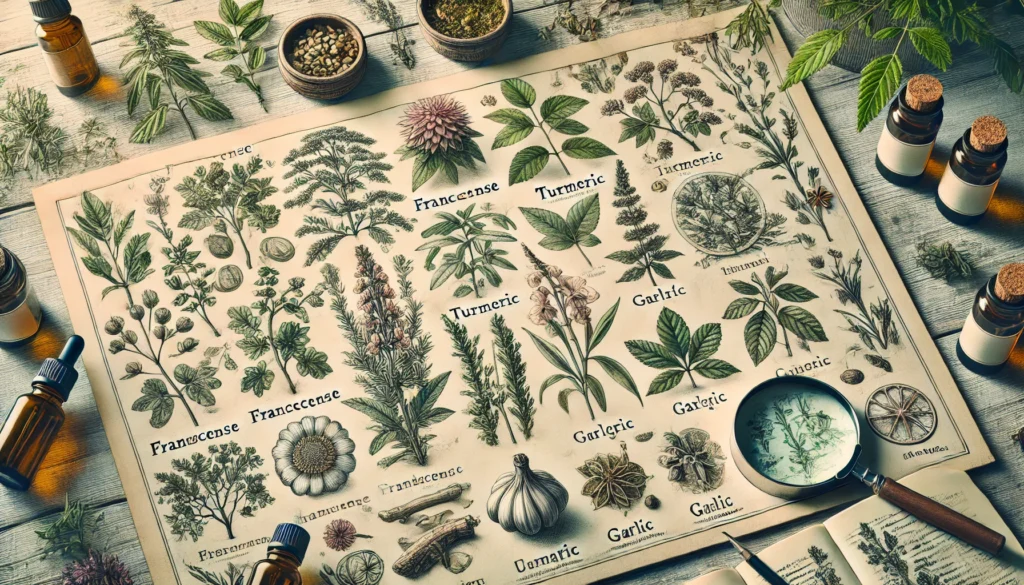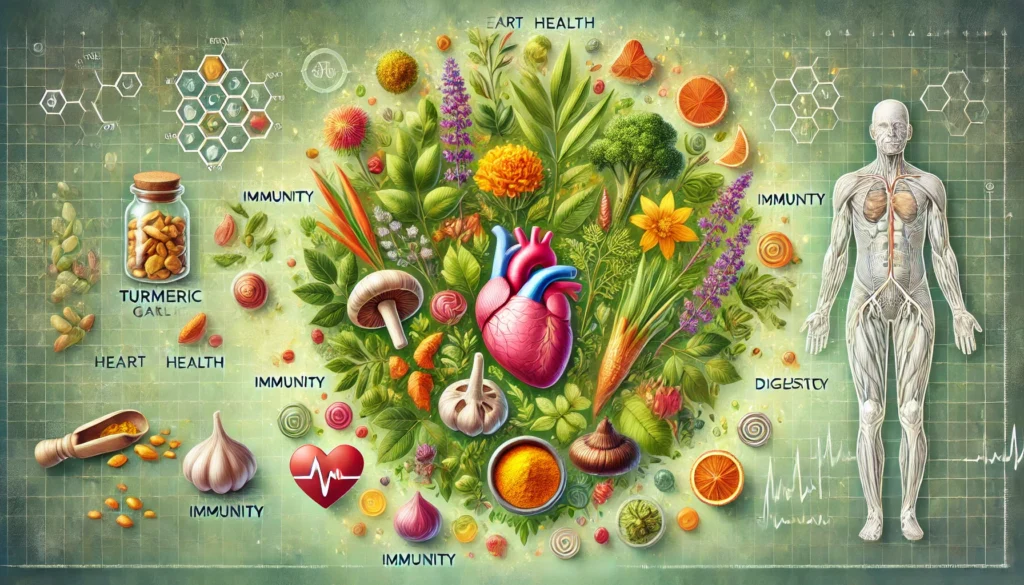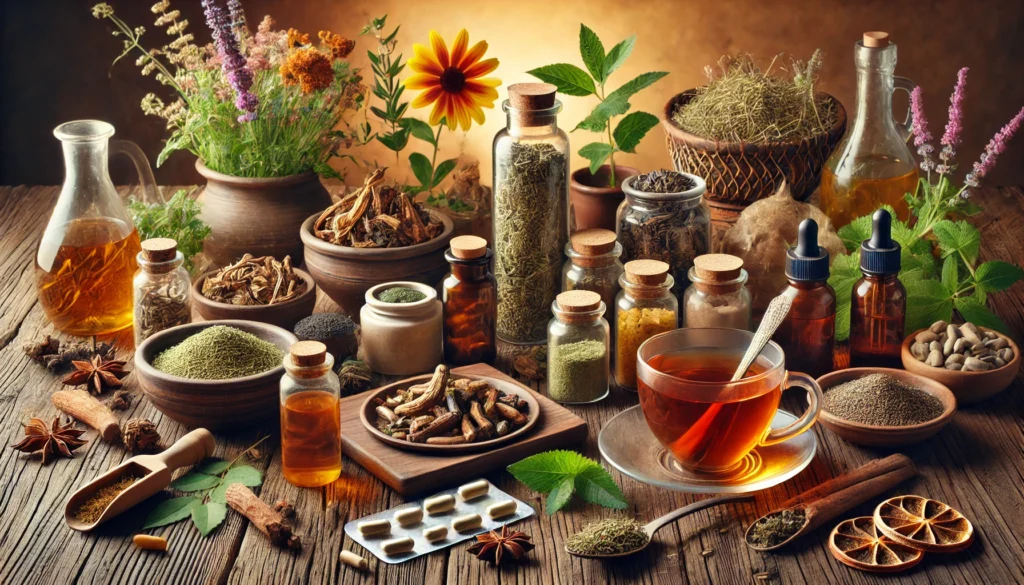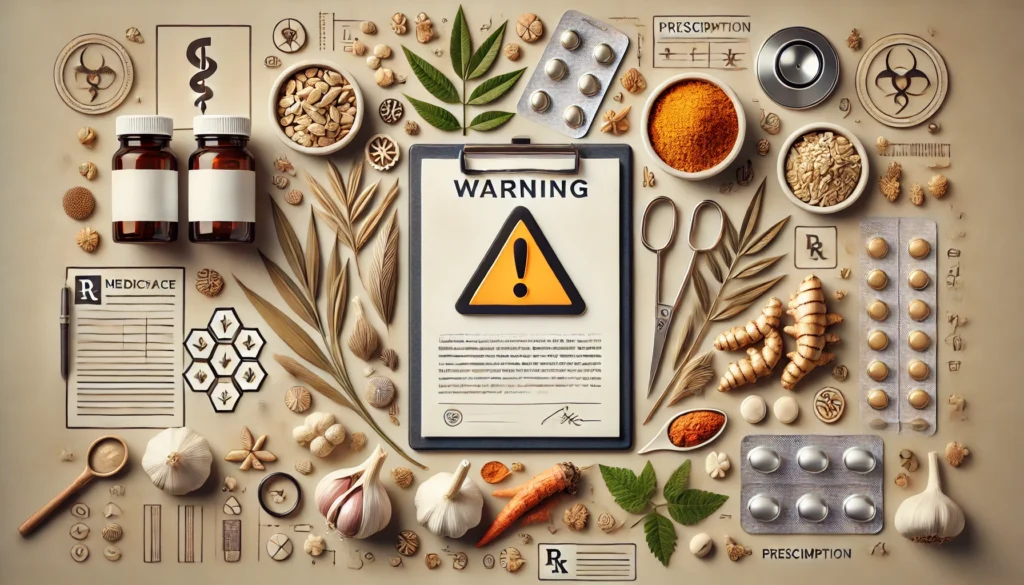Table of Contents
Licorice Root: A Timeless Remedy for Modern Health
Licorice root, derived from the plant Glycyrrhiza glabra, has been used for centuries for its medicinal and therapeutic properties. Known for its sweet flavor and impressive health benefits, licorice root has a long history of use in traditional medicine systems like Traditional Chinese Medicine (TCM) and Ayurveda. Today, it remains a popular natural remedy for a variety of conditions, including respiratory issues, digestive problems, skin health, and hormonal imbalances.
This comprehensive guide explores the history, health benefits, and practical uses of licorice root, along with essential safety considerations for those looking to incorporate it into their daily wellness routines.
This site contains affiliate links, and I may receive a commission on purchases made through them. Please see our Affiliate Disclosure for more details.

Historical Significance
Ancient Use in Egypt and China
Licorice root has a rich history stretching back thousands of years. In ancient Egypt, it was prized for its healing properties and used to create medicinal elixirs. The Egyptians believed in licorice’s ability to soothe digestive issues and respiratory ailments, and the root was even found in the tomb of King Tutankhamun, demonstrating its importance in ancient Egyptian culture.
Simultaneously, licorice was a cornerstone of Traditional Chinese Medicine (TCM), where it was known as “Gan Cao” and used to balance energy (qi) in the body. Chinese herbalists believed licorice root had a harmonizing effect, meaning it helped balance other herbs in formulations, enhance their effects, and neutralize toxins. It was also used to relieve coughs, digestive problems, and fatigue.
Licorice in Traditional Chinese Medicine (TCM)
Licorice root remains one of the most frequently used herbs in TCM today. Its use goes beyond treating specific ailments—it is valued for its ability to harmonize other herbs in formulas, making it a vital ingredient in many herbal mixtures. In TCM, licorice is used to strengthen the body’s energy, detoxify the body, and soothe inflammation, particularly in the digestive and respiratory systems.
Global Spread
Licorice’s medicinal value was not confined to China and Egypt. The Greeks and Romans also used licorice for respiratory and digestive ailments, and it eventually spread to Europe and other parts of the world. During the Middle Ages, licorice root was popular in Europe as a remedy for coughs and sore throats, and it became a common ingredient in herbal tonics and syrups.
In modern times, licorice root remains a popular herbal remedy around the world. From licorice tea and supplements to topical creams and extracts, it is widely used to support a variety of health conditions.

Botanical Profile
Plant Overview
Licorice root comes from the Glycyrrhiza glabra plant, a member of the legume family, which includes beans and peas. The plant is native to southern Europe, the Middle East, and parts of Asia, particularly regions with hot, dry climates. It grows as a perennial shrub, reaching up to 3–5 feet in height, with purple or pale blue flowers. The root of the plant, which is harvested for medicinal use, is long, fibrous, and brown on the outside with a yellowish interior.
Licorice root’s sweet taste is due to the presence of glycyrrhizin, a compound that is up to 50 times sweeter than sugar. However, it is this compound that is also responsible for many of the potential side effects associated with licorice root, including increased blood pressure.
Growing Conditions
Licorice thrives in warm, sunny climates and grows well in sandy or clay-like soil. It is native to the Mediterranean region but is also found in parts of Asia and India. It is a hardy plant that can grow in less fertile soils, making it relatively easy to cultivate in dry, arid conditions.
Different Varieties
Several species of licorice are used medicinally, but the most common is Glycyrrhiza glabra. Another frequently used species is Glycyrrhiza uralensis, which is widely used in Traditional Chinese Medicine. While these species share many of the same properties, there are some differences in their phytochemical profiles, which may affect their specific medicinal uses.

Nutritional and Phytochemical Profile
Licorice root’s health benefits are primarily due to its complex mix of bioactive compounds, which include glycyrrhizin, flavonoids, and saponins.
Active Compounds
- Glycyrrhizin: The most important and abundant compound in licorice root, glycyrrhizin is responsible for the herb’s sweet taste and many of its therapeutic effects. It has anti-inflammatory, antiviral, and immune-boosting properties, making it effective in treating a wide range of conditions. However, glycyrrhizin is also the compound that can lead to side effects like high blood pressure, making moderation important.
- Flavonoids: Licorice root contains several flavonoids, including liquiritin and isoliquiritin, which have antioxidant and anti-inflammatory effects. These flavonoids help protect cells from oxidative damage, reduce inflammation, and support overall health.
- Saponins: Another key group of compounds found in licorice root, saponins have anti-inflammatory, antiviral, and antibacterial properties. They are particularly useful in supporting immune function and fighting infections.
Other Phytochemicals
In addition to these main compounds, licorice root contains coumarins, polysaccharides, and essential oils, all of which contribute to its health benefits. Coumarins are known for their anticoagulant properties, while polysaccharides help support immune function and gut health.

Health Benefits of Licorice Root
Licorice root is one of the most versatile herbal remedies available, offering benefits for a wide range of conditions, from respiratory issues to digestive discomfort. Here are some of the most well-researched and widely recognized health benefits of licorice root:
Soothes Respiratory Conditions
Licorice root has long been used to treat respiratory issues such as coughs, bronchitis, and asthma. Its expectorant properties help clear mucus from the airways, making it easier to breathe. The anti-inflammatory effects of licorice also help soothe irritated tissues in the throat and lungs, reducing coughing and discomfort.
In traditional medicine, licorice root is often used in cough syrups and teas to relieve sore throats, colds, and chest congestion. It helps thin and expel mucus, which is particularly beneficial during respiratory infections.
Supports Digestive Health
Licorice root is well-known for its ability to soothe the digestive tract. It is particularly effective for treating heartburn, acid reflux, and gastric ulcers. Glycyrrhizin in licorice helps reduce stomach acid levels while also promoting the production of mucus that lines the stomach walls, protecting them from irritation.
A form of licorice called deglycyrrhizinated licorice (DGL) is often used to treat gastrointestinal issues. In DGL, the glycyrrhizin has been removed to prevent side effects like high blood pressure while still providing digestive benefits.
Anti-inflammatory Properties
Licorice root’s anti-inflammatory effects make it beneficial for treating inflammatory conditions such as arthritis, inflammatory skin disorders, and irritable bowel syndrome (IBS). Its compounds help reduce inflammation throughout the body by inhibiting the production of pro-inflammatory cytokines, which are responsible for swelling and pain.
In traditional medicine, licorice root is often combined with other anti-inflammatory herbs like turmeric or ginger to create natural remedies for joint pain and muscle inflammation.
Antiviral and Antibacterial Properties
Licorice root has been shown to have powerful antiviral and antibacterial properties, making it effective in treating infections like herpes, throat infections, and cold sores. Glycyrrhizin has been studied for its ability to inhibit the replication of viruses, including those responsible for the common cold, influenza, and herpes.
Licorice root’s antibacterial properties make it useful for preventing or treating bacterial infections, particularly those affecting the throat and digestive tract. Some studies have even explored licorice’s potential in combating H. pylori, the bacteria responsible for many stomach ulcers.
Balances Hormones
Licorice root has been traditionally used to balance hormones, particularly in women. It has a mild estrogen-like effect, which can help reduce symptoms of menopause and premenstrual syndrome (PMS), such as hot flashes, mood swings, and fatigue. Additionally, licorice root can help regulate cortisol levels, which play a key role in the body’s stress response.
By supporting adrenal function, licorice root helps the body cope with stress, fatigue, and anxiety. For people with adrenal fatigue, licorice can be a useful herbal remedy to improve energy levels and overall vitality.
Skin Health
Licorice root is a popular ingredient in skincare products due to its ability to reduce redness, inflammation, and hyperpigmentation. The flavonoids and other compounds in licorice help soothe irritated skin, making it beneficial for conditions like eczema, psoriasis, and acne.
Licorice’s ability to lighten dark spots and reduce skin discoloration also makes it a popular ingredient in brightening creams and serums. It helps reduce the appearance of scars, sunspots, and pigmentation caused by acne.
Immune System Boost
Licorice root has immune-boosting properties that enhance the
activity of white blood cells, which are crucial for fighting off infections. Its antioxidant properties also help protect the body from oxidative stress, supporting overall immune function.
For those looking to strengthen their immune system during cold and flu season, licorice root can be a useful addition to their wellness routine.
Detoxifying the Liver
Licorice root is often used to support liver health and aid in the body’s natural detoxification processes. It helps detoxify the liver by promoting the removal of toxins and reducing inflammation. In traditional Chinese medicine, licorice is used to cleanse the liver and support liver function, particularly in individuals who have been exposed to environmental toxins or medications.
Licorice’s antioxidant properties also help protect the liver from oxidative damage, which can occur due to poor diet, stress, or toxin exposure.
Weight Management
Emerging research suggests that licorice root may play a role in weight management by regulating body fat and reducing cravings. Some studies have found that licorice extract can help reduce body mass index (BMI) and body fat percentage by suppressing appetite and promoting fat metabolism. While more research is needed, licorice root shows promise as a natural aid for those looking to maintain a healthy weight.
Menopause and PMS Relief
Licorice root’s estrogen-like effects make it a valuable herb for women experiencing menopause or PMS. It helps reduce symptoms like hot flashes, mood swings, and fatigue by balancing hormone levels. Licorice also has mild adrenal-supporting effects, which can help alleviate stress and anxiety during menopause.
For women dealing with PMS, licorice root can be taken in the form of tea, capsules, or tinctures to ease discomfort and promote hormonal balance.

Methods of Consumption
There are several ways to consume licorice root depending on your health needs and preferences. Here are some of the most common methods:
Licorice Root Tea
One of the simplest ways to enjoy the benefits of licorice root is by brewing it as a tea. Licorice tea is often used to soothe sore throats, respiratory infections, and digestive discomfort. To make licorice tea, steep dried licorice root in hot water for 10–15 minutes. It can be combined with other herbs like ginger, peppermint, or chamomile to enhance its soothing effects.
Licorice tea is a great way to enjoy the respiratory and digestive benefits of licorice root without consuming too much glycyrrhizin, as the tea is generally milder than extracts or supplements.
Licorice Supplements (DGL)
For those who want to avoid the potential side effects of glycyrrhizin, deglycyrrhizinated licorice (DGL) supplements are a safer option. DGL is a form of licorice that has had the glycyrrhizin removed, allowing it to be used for digestive health without the risk of raising blood pressure.
DGL supplements are commonly used to treat acid reflux, heartburn, and stomach ulcers, and they are available in chewable tablets, capsules, or powder form.
Licorice Extracts and Tinctures
Licorice root extracts and tinctures offer a concentrated form of the herb and can be used to treat conditions like throat infections, coughs, and digestive issues. A few drops of licorice extract can be added to water or tea for quick relief of sore throats or stomach discomfort.
Tinctures are especially useful for those who need fast-acting relief and prefer not to brew tea or take capsules.
Topical Licorice
Licorice is also available in topical creams, serums, and ointments that are used for skin health. Topical licorice products are often used to reduce inflammation, treat acne, and lighten dark spots. Many skincare products include licorice extract as a natural remedy for eczema, psoriasis, and hyperpigmentation.

Cautionary Advice
While licorice root offers many health benefits, it is important to be mindful of its potential side effects, particularly when consumed in large amounts or over long periods.
Potential Side Effects
The primary concern with licorice root is its glycyrrhizin content, which can lead to elevated blood pressure, low potassium levels, and water retention when consumed in excess. These side effects are most common when consuming licorice root in extract form or in high doses. To avoid these issues, it is important to limit licorice intake and opt for DGL supplements if needed for long-term use.
Deglycyrrhizinated Licorice (DGL) as a Safer Option
For those with concerns about blood pressure or other glycyrrhizin-related side effects, DGL supplements are a safer alternative. DGL retains the digestive benefits of licorice root without affecting cortisol levels or blood pressure.
Medication Interactions
Licorice root may interact with certain medications, particularly blood pressure medications, diuretics, and corticosteroids. If you are taking medication for any of these conditions, consult your healthcare provider before using licorice root.
Safe Dosage
For general use, it is recommended to limit glycyrrhizin intake to no more than 100–200 mg per day. For long-term use, DGL supplements are preferred. Licorice tea, when consumed in moderation, is generally safe for most people.
Pregnancy and Nursing
Licorice root should be used with caution during pregnancy and breastfeeding, as it can affect hormone levels. Pregnant women should consult with their healthcare provider before using licorice supplements or extracts.

Conclusion
Licorice root is a time-tested herbal remedy that offers a wide range of health benefits, from supporting respiratory and digestive health to reducing inflammation and balancing hormones. Its rich history, versatility, and effectiveness make it a valuable addition to any natural health routine.
Whether you choose to enjoy licorice root as a tea, supplement, or topical treatment, it is important to use it responsibly and be mindful of potential side effects, especially when consuming large amounts or using extracts. Licorice root’s benefits can be harnessed safely with proper dosage and consideration of individual health needs.
Explore the many ways to incorporate licorice root into your wellness routine and experience the natural healing properties of this ancient herb.
